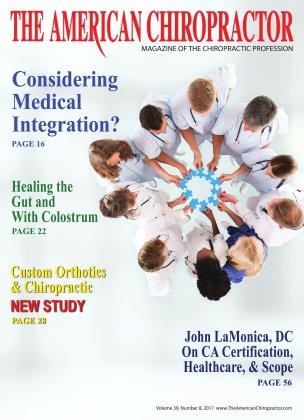Ask a patient, “What is the number one activity of daily living that you do?” and the likely answer is “Sitting!” Sitting, however, is not an activity. The correct answer is “walking.” Walking is still the most popular and most recommended form of physical activity for our patients. I explain to them that “You could be walking your way into health, or you could be walking with a dysfunction that you don’t even know you have.” A subtle altered gait can be the cause of, or a contributing factor to, many symptoms. I find that the majority of pain I treat, which results from injuries and disorders to muscles, nerves, joints, tendons, ligaments, cartiliage, and spinal discs, is experienced by people in the absence of recent trauma. Sports injuries, car accidents, slips, and falls have obvious cause and effects. The pain most often experienced by patients is a symptom of poor or faulty postures while sitting, standing, or walking (or a combination thereof).
But most patients experience what we call cumulative trauma disorders from repetitive stress and motion injuries. I’m convinced that starting a walking program, especially for a deconditioned patient, is beneficial in promoting physical fitness. In fact, walking presents the best evidence of efficacy for low back pain among all exercise regimens (ACSM). Before recommending a walking program, however, I check my patient’s mobility, especially in the feet, ankles, and hips. Keep in mind that the tests performed need to mimic the upright muscle actions observed while walking and not just those tests in a supine or prone position. A few checkpoints I like to
include are: standing foot intrinsic muscle activity, standing big toe extension, standing ankle dorsiflexon, standing hip extension movement pattern, one-legged stands, and stationary arm swings. Based on these simple tests I can begin to teach my patient how to better move during gait. Each patient deserves a proper diagnosis, which includes a history and examination process. My examination starts with a sitting and standing static posture evaluation and gait analysis with recommendations for improving posture and movement patterns. Improving static posture and movement dysfunctions is effective in reducing symptoms. Patients need to be educated and understand what “neutral posture” or “best form” or “proper position” is while sitting, standing, and walking. Here are my checkpoints for posture while walking:
I explain “Neutral spine” while checking the lumbopelvic region. Neutral spine is a pain-free position of the pelvis and lumbar spine attained when the pressures in and around the pelvis joint structures are evenly distributed. I show the patient how to get the pelvis balanced between anterior and posterior positions.
Feet: The feet should land on the center of the heel with the toes flexing upward. The feet should face closer to parallel than with the toes flaring outward; I especially look for symmetry of the feet; no excessive pronation or maintaining of supination.
Knees: I ask the patient to perform small knee bends. This mimics walking up or down stairs. The center of the patella should remain over the big toe or second toe. It should not deviate inward of the big toe or outward of the second toe.
Hips: Get the ilium in neutral and make sure they can move the femurs backward into extension at least 10 degrees. Describe the difference between quad-dominant motion and proper gluteal activation.
Abdominals: Engage the core muscles by pressing the navel toward the spine.
Chest: Don’t allow the ribs to flare out in the front. Ask the patient to lift the sternum and imagine a “tall spine.”
Shoulders: Ask the person to elevate the shoulders, then depress the shoulders, and then find the middle between the two points. Hold that position while protracting and retracting the shoulders, and find the middle between those two points. This position is neutral shoulders. Help the patient center the head of the humerus in the glenoid fossa.
Arms: The arms are connected to the scapula and the humerus needs to swing during gait. I often see people bend (flex and extend) at the elbow to give the illusion that they are swinging the arms. Cue them to move the arms forward and backward. This cue alone helps to move more efficiently and helps to unload the lumbar spine.
Hands: The hands/fingers should be slightly flexed, not gripping. They should not have fully extended fingers.
Head: Imagine a balloon tied to the occiput gently lifting the head. The eyes should be looking far ahead and to the top of trees rather than at the ground.
Walking programs: I encourage a 3to 5-minute warmup performed at an easy walking pace; and then move to a moderate (talking to a partner is easy) walking speed and buildup to a brisk pace (not able to deliver a monologue). A simple recommendation to patients is “Get in 150 minutes per week of walking” or try the “10,000 steps a day” approach. If a patient needs weight loss, I tie my recommendations into the number of calories I need the patient to burn per week to achieve fat loss. This is based on my body composition analysis device.
If we can chronically improve gait function through postural awareness and chiropractic care, then the varied symptoms of repetitive altered gait can be lessened.
References:
1. American College of Sports Medicine. ACSM’s Guidelines for Exercise Testing and Prescription, 10th ed. RiebeD, Ehrman JK, Liguori G, Me gal M, editors. Baltimore, MD: Lippincott Williams & Wilkins, 2017.
Dr. Jeffrey Tucker is the current secretary/treasurer oftheACA Rehab Council. He practices inLosAngeles, Ca4fornia. His website is www.D rJeffrey Tucker corn.
 View Full Issue
View Full Issue









